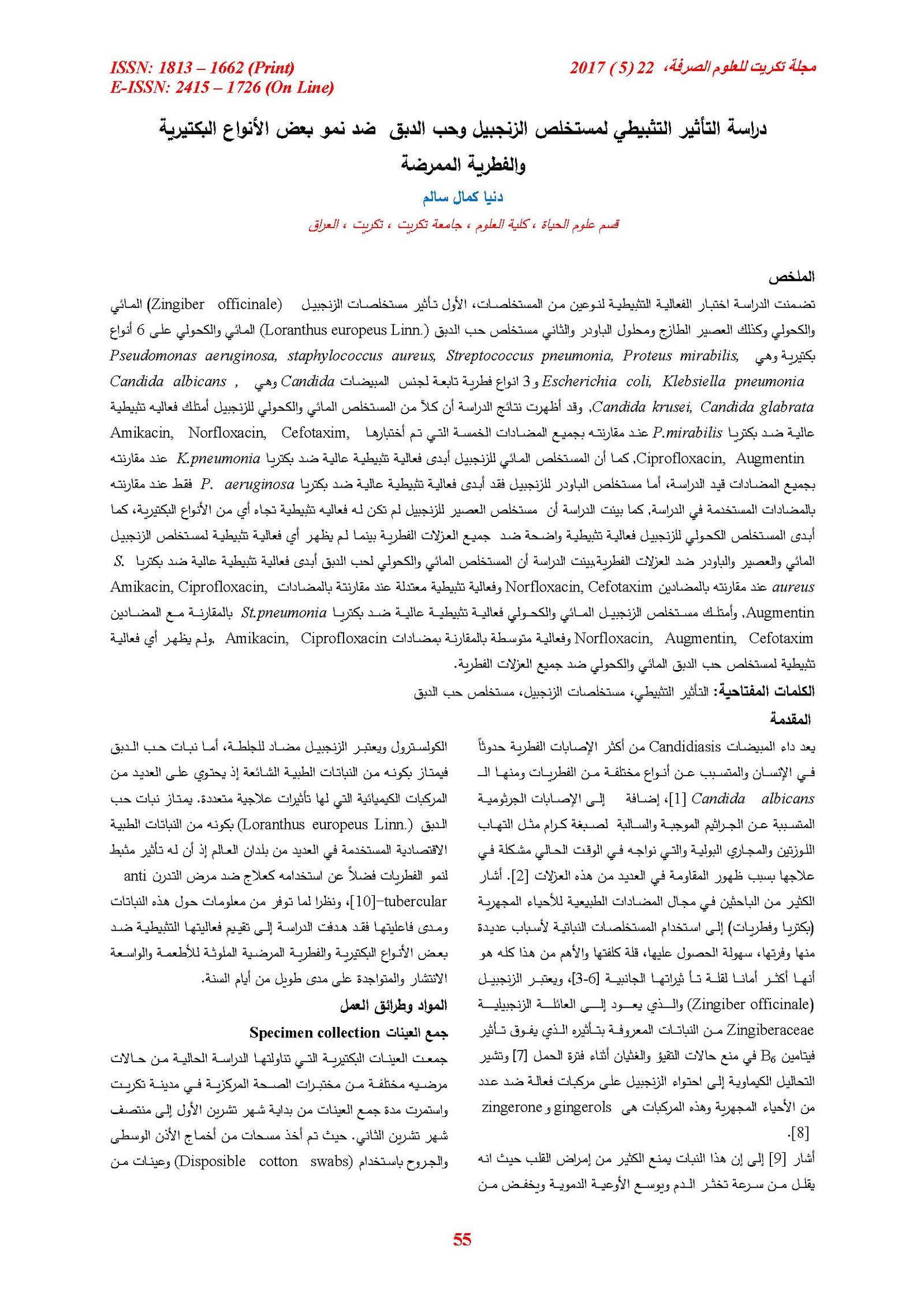Study the inhibitory effect of Genger and Altbek grain against the growth some pathogenic bacterial and fungal species
Main Article Content
Abstract
This study included the test of Antimicrobial activity for two types extracts, the first is effect of aqueous, alcoholic, fresh juice and powder ginger extract .The second is the aqueous and alcoholic extract of Altbek grain on sex bacterial species: Pseudomonas aeruginosa, Staphylococcus aureus, Streptococcus pneumonia, Proteus mirabilis, Escherichia coli, Klebsiella pneumonia and 3 fungal species belonging to the genus Candida: Candida albicans, Candida krusei, Candida glabrata . The results showed that both the aqueous and alcoholic for genger have high inhibited activity against p.mirabilis comparison all five tested antibiotics ,Also have the aqueous extract of ginger high activity against K .pneumonia when compared to all Antibiotics used in the study, either powder extract of genger have high inhibited activity against only P.aeruginosa while not showed any effective inhibition against bacterial and fungal species, also showed effective inhibition for alcoholic extract of genger against all fungal species, While not showed any effective inhibition for aqueous, juice and powder extract against fungal species. The study showed the aqueous and alcoholic Altbek grain have high effective activity against S.aureus comparison to Antibiotics: Cefotaxim, Norfloxacin and moderate effective when compared to Antibiotics: Amikacin, Ciprofloxacin, Augmentin, The aqueous and alcoholic genger extract have highly effective inhibition against S.pneumonia compared of Antibiotics: Norfloxacin, Augmentin, Cefotaxim and medium effective compared with Antibiotics: Amikacin, Ciprofloxacin, and did not appear any effective inhibition against all fungal species.
Article Details

This work is licensed under a Creative Commons Attribution 4.0 International License.
Tikrit Journal of Pure Science is licensed under the Creative Commons Attribution 4.0 International License, which allows users to copy, create extracts, abstracts, and new works from the article, alter and revise the article, and make commercial use of the article (including reuse and/or resale of the article by commercial entities), provided the user gives appropriate credit (with a link to the formal publication through the relevant DOI), provides a link to the license, indicates if changes were made, and the licensor is not represented as endorsing the use made of the work. The authors hold the copyright for their published work on the Tikrit J. Pure Sci. website, while Tikrit J. Pure Sci. is responsible for appreciate citation of their work, which is released under CC-BY-4.0, enabling the unrestricted use, distribution, and reproduction of an article in any medium, provided that the original work is properly cited.
References
[1] Midgley, G.; Clayton, Y.M. & Hay, R.J. (1997). Diagnosis in color medical mycology. Mosby- wolfe, an imprint of mosby international, Spain 155 p.
[2] Alves, M.A.; Silda, A.F.; Drandao, M.: Grandi, T. S.M.; Smania, E.F.A.; Junior, A.S. & Zani, C.L. (2000). Biological screening of Brazilian medical plants. Men. Inst. Oswaldo. Cruz, Riodejanerio. 95(3): 367-373.
[3] DeBoer, H.J., Kool, A., Broberg, W.R., Mziray, I., Hedberg and Levenfors, J.J. (2005). Antifungal activity of some herbal remedies from Tanzanias. J. Ethnopharmacol., 96: 461-469. DOI: 10.1016/J.jep.2004.09.035.
[4] Alzoreky, N.S. and Nakahara, K. (2003). Antibacterial activity of extracts from some edible plants commonly consumed in Asia International. J. Food Microbiol., 80: 223- 230. DOI: 10.1016/so168-1605 (02) 00169-1.
[5]- Konning, G.H., Agyare, C., and Ennison, B. (2004). Antimicrobial activity of some medicinal plants from Ghana. J. Phytother., 75: 65-67. DOI: 10.1016/J.fitote.2003.07.001.
[6] Adel, M. and Mahasneh, A. (1999). Antimicrobial activity of extracts of herbal used in the traditional medicine of Jordan. J. Ethnopharmacol., 64: 271-276. DOI: 10.1016/so378- 8741(98) 00132-9.
[7] Chittumma, P: Kaewkiattikun, K. and Wiriyasiriwach, B. (2007). Comparison of the effectiveness of ginger and vitamin B6 for treatment of nausea and vomiting in early pregnancy: a randomized double-blind controlled trial. J. Med. Assoc. Thai. 90(1): 15-20.
[8]- Ficker, C., Smith, M.L. and Akpagana, K. (2003). Bioassay-guided isolation and identification of antifungal compounds from ginger. J. Phytother. Res., 17: 897- 903. DOI: 10.1002/ptr.1335.
[9] Akoachere JF, Ndip RN, Chenwi EB (2002). Antibacterial effect of 348 J. Med. Plants Res. Zingiber officinale and Garcinia kola on respiratory tract pathogens. East Afr. Med. J., 79: 588- 592.
[10] Chakravarty, H. L.(1976). Plant wealth of Iraq (a dictionary of economic plants). Vol.1, Ministry of Agriculture and Agrarian Reform, Baghdad, Iraq, 107-335.
[11] Collee JG, Fraser GA, Marmion PB, and Simmons A. (1996). Practical Medical Microbiology. 4th. Churchill Livingstone, New York. P. 413-418.
[12] Cruickshank R, Duguid JP, M armion BP, and Swain RH. (1975). Medical Microbiology. 12th. New York. Churchill Livingstone.
[13] Benson HJ. (2002). Microbiological application: Laboratory manual in general microbiology. 8th ed. McGraw Hill. New York.
النال ، 39 - . 47[15] Reuter, H.D., Dock, H.P. and Lawson, D.L. (1996). Therapeutic effects and applications and its preparations in garlic. The Science and Theraputic applications of Allium sativium L. and related species. 2nd Ed.pp.135 – 212.
[17] Jarosz, J. and Lipa, J.J. (1990). Fungistatic an Fungicidial activity of Albarep and garlic juice against phytopathologenic fungi. Rocz. Nauk Rol. Ser. E. 20:53-59.
[19] Vandepitte, J; Engback, K; Poit, P. and Heuck, C. (1999). Basic laboratory proceduresin clinical bacteriology. World Health Organisation, Geneva.
[20] Pajaka, j; Patil, j. and Ghosh,s. (2010). Antimicrobial activity of Catharanthus roseus- adetailed study. British. J. pharm and Toxicology. ISSN: 2044-2467.
[21] Geiger, J.L. (2005). The essential oil of ginger, Zingiber officianle, and anathesia. The international Journal of Aromatherapy. 15: 7-14.
[22] pundir, R.K. and Jain, P. (2010). Antifungal activity of twenty two ethanolic plant extracts against food-association fungi. Journal of Pharmacy Research. 3(1): 506-510.
[26] Bruneton, J.(1999). Pharmacognosy phytochemistry medicinal plants. Technique and documentation editions medicales internationals, France. 2nd ed. pp. 335.
[27] Gur, S; Turgut- Balik, D. and Gur, N. (2006). Antimicrobial activities and fatty acids of turmeric, ginger root and linseed used in the treatment of infectious diseases. Wourld Journal of Agricultural Sciences. 2(4): 439-442.
